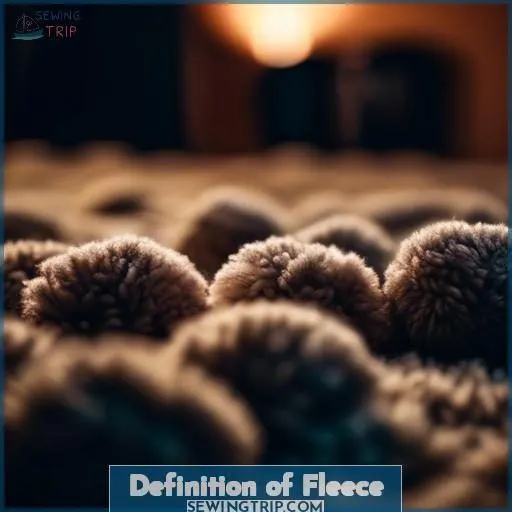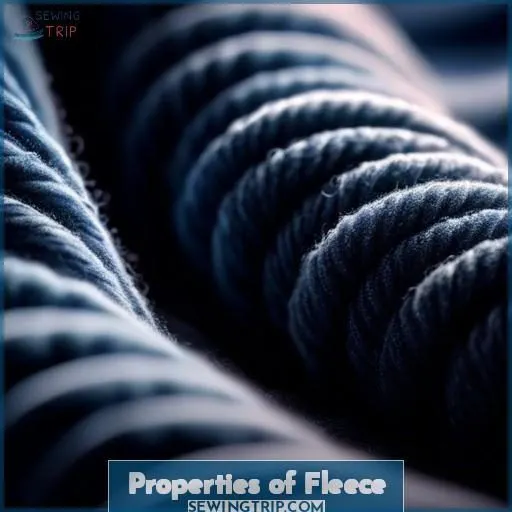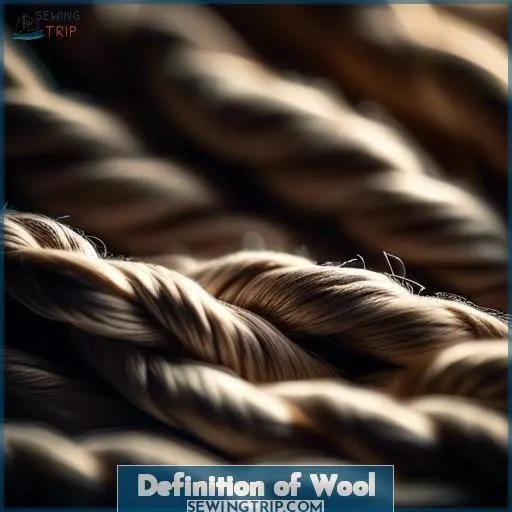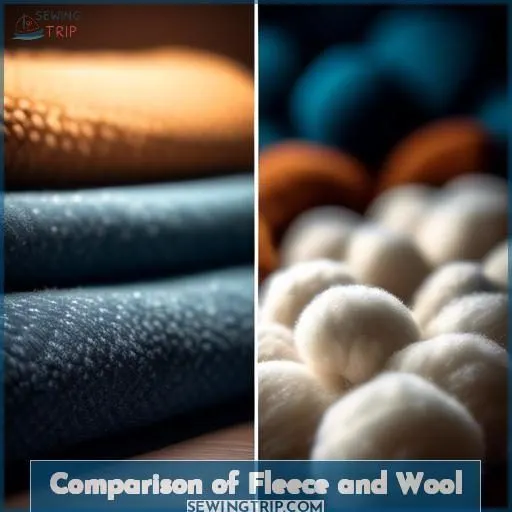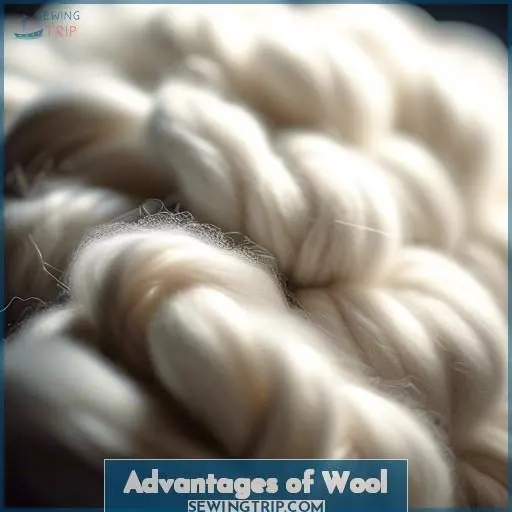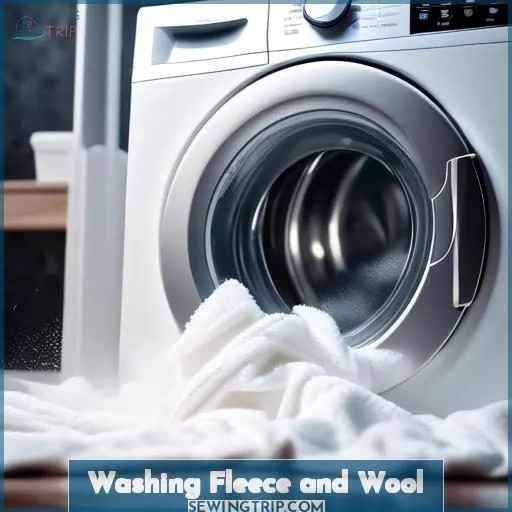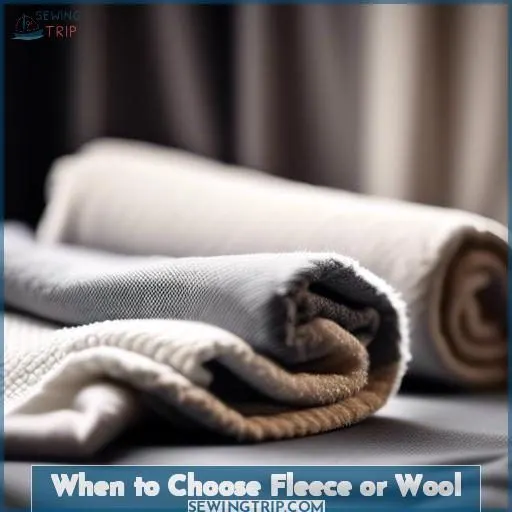This site is supported by our readers. We may earn a commission, at no cost to you, if you purchase through links.

In the cotton vs fleece difference battle, you’ll find distinct properties.
Fleece, a synthetic fabric, excels in lightweight, quick-drying, and easy-maintenance qualities, while retaining softness and avoiding shrinkage.
Cotton, a natural fiber, offers breathability, moisture-wicking, and inherent antimicrobial properties.
Fleece boasts superior wind resistance and insulation when wet. Cotton, on the other hand, provides initial warmth in damp conditions.
Consider your needs – fleece for versatility and moisture resistance, or cotton for sustainable breathability.
Want to explore further into the warmth, softness, and breathability comparison?
Table Of Contents
Key Takeaways
- Fleece is a synthetic fabric known for its lightweight, quick-drying, and easy-maintenance qualities. It offers superior wind resistance and insulation when wet.
- Cotton is a natural fiber that provides breathability, moisture-wicking, and inherent antimicrobial properties. It offers initial warmth in damp conditions.
- When choosing between fleece and cotton, consider your needs – fleece for versatility and moisture resistance, or cotton for sustainable breathability.
- Fleece has an environmental impact due to its synthetic materials, but it’s lightweight, quick-drying, and easy to maintain. Cotton is a natural fiber that requires more care but offers breathability and moisture management.
Definition of Fleece
Fleece is a synthetic fabric that resembles wool, made of polyester or a blend of synthetic fibers.
It’s brushed to create volume and softness, making it a popular choice for clothing and insulation.
Fleece production can involve recycled materials, and it’s often used for warmth and insulation.
It’s lightweight, quick-drying, easy to maintain, and doesn’t shrink like wool.
Fleece is also soft and not itchy, making it a comfortable choice for many.
However, fleece has an environmental impact, as it’s made from synthetic materials, and its production may not be as eco-friendly as other fabrics.
Properties of Fleece
You’re drawn to fleece because it’s incredibly lightweight, making it ideal for layering or packing for travel. Yet, its quick-drying capabilities mean you can wear fleece during activities where you might work up a sweat, as the moisture will evaporate rapidly. Additionally, fleece requires minimal maintenance compared to natural fibers – it resists shrinking and won’t itch against your skin.
Lightweight
When preparing for an outdoor excursion, whether it involves traversing trails or establishing a campsite, selecting lightweight materials such as fleece can be highly advantageous.
Its pile fabric construction not only provides excellent airflow and breathability but also guarantees that your outdoor clothing and camping equipment won’t burden you.
This compact nature makes fleece an ideal choice for travel and hiking attire.
Quick Drying
Essential factor is a key consideration when selecting between fleece and cotton for outdoor pursuits, particularly when it’s imperative to remain dry and comfortable. Fleece’s renown for its quick-drying characteristic is a substantial advantage over cotton.
Fleece is comprised of synthetic fibers, such as polyester, enabling it to dry more rapidly than cotton when exposed to moisture. This is attributable to the hydrophobic nature of synthetic fibers, which repel water and absorb less moisture. When fleece becomes wet, it dries promptly due to the fabric’s wicking capabilities, which facilitate the transfer of moisture away from the skin into the environment.
Conversely, cotton readily absorbs water and requires an extended period to dry. This can be detrimental when engaging in hiking or other outdoor activities where quick drying is paramount. Cotton possesses superior breathability compared to fleece, but it may not provide the same level of moisture management, particularly in wet conditions.
In terms of laundering, both fleece and cotton necessitate distinct care. Fleece should be washed using a gentle detergent, inverted, and washed on a cooler setting. Tumble drying on low or air drying is recommended to prevent shrinkage and fabric damage. Cotton, on the other hand, should be washed in cool water and not dried at excessive temperatures to prevent shrinkage and damage.
When making a choice between fleece and cotton, consider the intended activity, the prevailing weather conditions, and your personal preferences for comfort and moisture management. Fleece is the optimal choice for quick drying and moisture management, while cotton is more breathable and suitable for warmer conditions.
Easy Maintenance
Regarding easy maintenance, fleece stands out as a clear victor. Unlike wool, which necessitates specific care and vigilance, fleece is engineered for minimal upkeep. Here’s wherefore:
- Lightweight: Fleece is featherweight and requires minimal effort for cleansing. It’s ideal for those desiring to minimize laundry time and maximize enjoyment of outdoor pursuits.
- Quick Drying: Fleece desiccates swiftly, a significant advantage when traveling. There’s no need for protracted waiting for your fleece to be prepared for the upcoming adventure.
- Easy to Wash: Fleece is amenable to machine washing, rendering it a practical option for those seeking to conserve time and energy. Simply adhere to the care guidelines on the label, and you’re all set.
No Shrinkage
Concerning shrinkage, fleece triumphs over cotton. Fleece, thanks to its synthetic essence, exhibits less shrinkage, while cotton succumbs to it more readily, particularly when subjected to elevated wash and dry temperatures. This stems from cotton’s inherent inclination to revert to its initial form under heat, triggering fabric constriction.
To thwart cotton shrinkage, manufacturers frequently pre-shrink the material ahead of garment production. This process alleviates much of the inherent tension, diminishing any subsequent shrinkage encountered by the consumer. Despite pre-shrinking, cotton retains the potential to shrink up to 5% during laundering.
Conversely, fleece, notably PET-based fleece, exhibits reduced shrinkage due to its synthetic constitution. To prevent shrinkage, it’s prudent to avoid washing fleece in hot water or drying it at high temperatures.
Soft and Not Itchy
Fleece is a soft and not itchy fabric that’s perfect for those who want to stay warm without the discomfort of wool. Here are four reasons why fleece is a great choice:
- Comfortable: Fleece is soft and warm, making it a comfortable choice for any occasion.
- Durable: Fleece is made of synthetic fibers that are resistant to wear and tear, ensuring that your garment lasts longer.
- Hypoallergenic: Fleece is hypoallergenic, making it a great choice for those with sensitive skin.
- Breathable: Fleece is breathable, allowing air to circulate and keeping you cool when you’re active.
Definition of Wool
Shifting focus from the modern marvel of fleece, let’s explore the intricate fabric of wool. This time-honored material boasts a rich history, with its production tracing back millennia. Wool grades differ, offering a range from coarse to fine, each with its distinctive allure. Wool blends harmoniously combine the finest qualities of wool with other fibers, elevating both functionality and style. However, it’s crucial to acknowledge that some individuals may experience discomfort due to wool allergies.
| Wool’s Heritage | Modern Twists |
|---|---|
| Ancient warmth | Innovative blends |
| Shearing traditions | Enhanced textures |
| Diverse grades | Allergy awareness |
| Timeless style | Eco-consciousness |
| Cultural staple | Fashion-forward |
Properties of Wool
Wool’s natural properties make it a versatile fabric for various conditions. It’s somewhat water repellent due to the presence of lanolin, a waxy substance that helps it insulate when wet, and is also flame retardant, breathable, and naturally antimicrobial, making it resistant to odors.
Somewhat Water Repellent
Concerning water resistance, wool possesses some water-repellent properties. This implies that it can better endure moisture compared to certain other materials. In humid environments, wool can aid in preventing the absorption of sweat. Nevertheless, it mightn’t be as efficient in materials that are thin. Therefore, if you seek a fabric that can manage water, wool is a viable option.
Insulates When Wet
Wool is a natural fiber that maintains its insulating properties when wet, even in damp conditions.
This is due to its unique structure and the presence of lanolin, a waxy material secreted by sheep’s sebaceous glands that makes their coats repel water.
When wool fibers absorb water, they can retain a significant amount of moisture without feeling wet and clinging to the skin, which helps maintain a higher skin temperature and less rapid cooling.
This moisture-wicking property allows wool to keep you warm and dry in wet conditions, making it an excellent choice for outdoor activities where you may encounter rain or snow.
Flame Retardant
Considering flame resistance, wool is an indisputable victor. Wool possesses an inherent flame resistance, surpassing other fibers in fire safety. It refrains from melting, dripping, or adhering to the skin during combustion, opting instead for smoldering over intense burning. This behavior stems from wool’s substantial nitrogen and water content, demanding higher oxygen levels for ignition, and its cross-linked cell membrane structure, which expands under heat, forming an insulating barrier to impede flame propagation.
In contrast, fleece, a synthetic fabric composed of polyester or blends, lacks the inherent flame resistance of wool. Though it may exhibit some degree of fire resistance owing to its synthetic composition, it falls short of providing the same level of protection. Fleece has the potential to melt, drip, or cling to the skin when burning, potentially causing more severe burns in a localized area compared to wool.
In a direct comparison, wool emerges as the more flame-resistant choice. Its likelihood of ignition is lower, it doesn’t melt or drip, and it possesses the ability to self-extinguish in the event of ignition. Fleece, while potentially offering some fire resistance due to its synthetic nature, can’t match the level of protection offered by wool.
Breathable
Regarding breathability, wool excels. Its innate fibers permit air circulation, maintaining coolness during summer and warmth in winter.
Yet, fleece exhibits comparable breathability, boasting ample airflow and moisture-wicking abilities.
Comparing breathability, both fleece and wool would score highly, with wool holding a slight advantage due to its inherent breathability. This aspect is pivotal for temperature regulation, enabling the body to achieve a comfortable temperature without excessive heat or cold.
Naturally Antimicrobial
Wool is naturally antimicrobial, which is one of the reasons it’s often used for next-to-skin products like underwear, socks, and base layers.
This property is due to the presence of lanolin, a natural oil found in wool. Lanolin can absorb moisture and prevent the growth of bacteria that cause odor.
Wool’s ability to absorb moisture helps keep the skin dry, reducing the amount of body odor that develops from sweat and its contact with bacteria. This is particularly effective in wool garments that are worn for extended periods without washing, such as during sports or travel.
Comparison of Fleece and Wool
When comparing fleece and wool, you’ll find that both fabrics excel in different areas. Fleece offers superior wind resistance and dries faster when wet, while wool boasts better water repellency, breathability, and natural antimicrobial properties that resist odors.
Warmth and Insulation
Concerning warmth and insulation, both fleece and wool are exceptional options. However, wool provides superior initial insulation in wet conditions due to lanolin, while fleece dries more rapidly when damp. Fleece also exhibits greater resistance to wind, offering enhanced insulation in windy conditions. Both materials surpass cotton in warmth and water resistance.
Water Resistance
Regarding water resistance, both fleece and wool exhibit distinct advantages.
Fleece can be treated with water-resistant coatings to improve its ability to repel moisture, rendering it appropriate for use in rainwear.
Wool, on the other hand, is inherently somewhat resistant to water and offers insulation even when wet, making it a suitable choice for outdoor gear.
Nonetheless, fleece exhibits faster drying properties when wet, providing superior insulation in windy conditions.
Wind Resistance
In terms of wind resistance, fleece and wool exhibit their respective capabilities. Fleece stands out as a suitable option for outdoor pursuits and athletic attire due to its superior wind resistance compared to wool.
Conversely, wool boasts enhanced water resistance, making it the preferable choice for cold-weather garments.
When it comes to winter gear, both fabrics offer warmth and insulation. Fleece excels in drying faster when damp, while wool provides more initial insulation in wet conditions.
Breathability
Regarding breathability, fleece and wool possess distinct advantages. Fleece boasts exceptional moisture-wicking capabilities, ensuring dryness and comfort. Its excellent airflow promotes ventilation, making it ideal for outdoor pursuits. Wool, conversely, is inherently breathable and permits perspiration, aiding in body temperature regulation. Both materials offer comfort in their respective ways, with the optimal choice dictated by individual preferences and requirements.
Sustainability
Shifting from breathability to sustainability, let’s unravel the eco-tale of fleece and wool. Your choice of fabric can leave a footprint, so tread lightly!
| Fabric | Carbon Footprint | Recycling Potential |
|---|---|---|
| Fleece | Higher due to synthetic origin | Often made from recycled materials |
| Wool | Lower when ethically produced | Biodegradable, but less recycled |
Wool’s ethical production weaves a greener narrative, while fleece’s recycling saga turns old bottles into cozy tales.
Advantages of Fleece
Fleece offers countless advantages that make it an exceptional choice for your activewear and outdoor gear. With its versatility, moisture-resistance, insulating properties, and undeniable softness, fleece truly stands out as a superior fabric option.
Versatile
Fleece and cotton are two popular fabric options for clothing and bedding, each with its own unique properties and advantages. Regarding versatility, fleece and cotton both have their strengths.
Fleece is a synthetic fabric made from polyester or a polyester blend, often brushed for volume and softness. It’s known for its lightweight, quick-drying, easy-maintenance, and non-shrink properties. Fleece is also very soft and not itchy, making it a comfortable choice for various applications.
Cotton, on the other hand, is a natural fiber derived from the cotton plant. It’s known for its softness, breathability, and absorbency. Cotton is also durable and can endure frequent use and washing, making it suitable for a wide range of products, including workwear, uniforms, and sportswear.
When comparing the versatility of fleece and cotton, it’s essential to examine factors such as durability, sustainability, and cost.
Durability:
- Fleece is generally considered less durable than cotton, but its eco-friendliness can vary depending on the manufacturing process and use of recycled materials.
- Cotton is known for its moderate strength and can endure daily wear and tear when properly cared for.
Sustainability:
- Fleece can be sustainable if it’s made from recycled materials, such as recycled plastic bottles. However, the production process of fleece itself isn’t always environmentally friendly.
- Cotton is a more sustainable choice as it’s a natural fiber that can be grown without the use of synthetic chemicals.
Cost:
- Both fleece and cotton are relatively inexpensive, making them accessible to a wide range of consumers.
Moisture-Resistant
Fleece is a moisture-resistant fabric that wicks away sweat and moisture, keeping you dry and comfortable. It’s an excellent option for outdoor activities and sports, where managing moisture is essential.
In contrast, cotton is less moisture-resistant and can absorb moisture, which can make it uncomfortable and heavy. However, cotton is more breathable, allowing for improved airflow.
Regarding cost-effectiveness, fleece is a more economical choice for moisture management than other high-performance fabrics.
Insulating
Fleece is an outstanding insulator, particularly for cold climates. Its thickness and moisture-wicking capabilities render it ideal for maintaining body temperature. Fleece preserves warmth even when damp, which is essential in challenging conditions. This makes it an exceptional option for those who require warmth in frigid environments.
Soft
Venturing into the comfortable domain of fabrics, let’s compare fleece’s artificial softness with cotton’s inherent tenderness. Fleece texture, reminiscent of a comforting embrace on a frigid day, surpasses cotton in terms of softness, providing a fluffy embrace devoid of the irritation frequently encountered with natural alternatives.
This synthetic versus natural softness competition elevates fleece as the indisputable victor of comfort, enveloping you in unmatched softness.
Advantages of Wool
Wool, a natural fiber from sheep and mammals, has been used for warmth for centuries. It’s collected via shearing and has several unique properties that make it a popular choice for various applications. Here are some of the advantages of wool:
- Flame Retardant: Wool is naturally resistant to flames due to its high ignition temperature and self-extinguishing properties. It forms a soft dissipating ash residue when burned, making it safer than materials like cotton and rayon.
- Breathability: Wool is highly breathable, allowing air to circulate and regulate body temperature, making it ideal for use in clothing and textiles.
- Moisture Wicking: Wool has excellent moisture-wicking capabilities, drawing moisture away from the skin and keeping it dry.
- Antimicrobial: Wool has natural antimicrobial properties, resisting stink and bacteria, which is beneficial for health and hygiene.
- Sustainability: Wool is a renewable and biodegradable resource, as sheep produce a new fleece each year. It also uses less energy and water compared to synthetic fibers like polyester.
- Comfort: Wool is soft and comfortable when used in high-quality wool, such as Merino wool.
- Low Flammability: Wool has a higher limiting oxygen index (LOI) compared to cotton and rayon, meaning it requires more oxygen to keep burning.
- Wool Blends: Wool can be blended with other flame-resistant fibers like m-aramid, p-aramid, Modacrylic, and FR viscose to improve its fire-retardant performance.
- Versatility: Wool is used in a wide range of applications, including clothing, interior textiles, and industrial applications.
Washing Fleece and Wool
When washing fleece and wool, it’s imperative to adhere to the appropriate care guidelines. For fleece, utilize a gentle detergent, launder on a less warm setting, and tumble dry on low or air dry; for wool, manually wash in cool water and refrain from using the dryer to avert shrinkage.
Fleece
Fleece is a synthetic fabric made from polyester or blends, brushed for volume and softness. It’s lightweight, quick-drying, easy to maintain, and doesn’t shrink like wool. Fleece is also soft and not itchy, making it a popular choice for warmth and comfort.
When washing fleece, use a mild detergent and avoid fabric softener. Turn it inside-out, wash on a cooler setting, and tumble dry on low or air dry.
Wool
Wool is a natural fiber obtained from sheep and other mammals. Its history dates back to ancient civilizations, where it was used for warmth and protection. Today, the wool industry is a significant contributor to the global economy.
Wool is known for its sustainability, as it’s biodegradable and can be recycled. Wool production involves shearing sheep, which is a non-invasive process.
Wool blends are common in the fashion industry, combining wool with other fibers for enhanced properties.
When to Choose Fleece or Wool
When deciding between fleece or wool, consider the cost, weight, and odor resistance of each fabric. Fleece tends to be more budget-friendly and lightweight, while wool is naturally odor-resistant – so choose based on your specific needs and preferences.
Cost
Regarding cost, selecting between fleece and wool hinges on considerations such as production cost, retail cost, and cost per use. While fleece is typically more economical in terms of retail cost, wool may prove more cost-effective over the long term owing to its durability and resilience to wear and tear.
Furthermore, the cost comparison between the two can fluctuate based on the specific type of fleece or wool being considered.
Weight
Regarding the choice between fleece and wool, weight is crucial. Fleece is typically lighter, making it preferable for those bothered by heavy fabrics. Wool, conversely, is heavier, aiding its warmth-retention ability by trapping air. However, wet wool becomes heavier and dries slower, which can be problematic in certain scenarios.
For weight-related considerations, fleece is often chosen for its lightness, particularly in cold and wet conditions where it outperforms wet wool in terms of warmth. On the other hand, wool may be more suitable for cold but dry conditions, as it provides greater warmth than fleece in such settings.
Odor Resistance
Regarding odor resistance, fleece and wool boast distinct benefits.
Fleece possesses a wicking capability that aids in rapid drying, hindering the proliferation of odor-inducing bacteria. This renders it a more suitable option for individuals susceptible to allergic reactions.
Conversely, wool exhibits an inherent moisture absorption capacity that stabilizes temperature and minimizes odor, making it a favored choice for outdoor pursuits.
Each fabric holds its own advantages, so the selection between them hinges upon your particular requirements and preferences.
Frequently Asked Questions (FAQs)
How does fleece compare to wool in terms of insulation when wet?
As the rain pelts, fleece keeps you cozy like a snug hug, while wool’s once-mighty insulation power wanes when saturated. Fleece dries rapidly, restoring its warmth advantage.
What are the environmental impacts of using fleece versus cotton?
You’re concerned about the environment? Fleece, made from petroleum-based synthetics, has a larger carbon footprint than cotton. But cotton requires huge amounts of water and pesticides during cultivation. Both have trade-offs, but cotton edges out fleece as the more eco-friendly choice.
How does the breathability of fleece compare to that of cotton?
Fleece is noticeably more breathable than cotton. Its synthetic fibers facilitate exceptional airflow, ensuring comfort during vigorous activities. Conversely, cotton can feel suffocating due to its comparatively limited breathability.
Is fleece more durable than cotton, and if not, what are the differences in durability?
Let’s say you’re hiking and accidentally tear your jacket – cotton would rip more easily than fleece’s tougher synthetic fibers. Generally, fleece outperforms cotton’s durability due to its stronger material composition.
How does the comfort of fleece compare to cotton, especially in different weather conditions?
You’ll find fleece supremely comfy year-round – its soft fuzziness keeps you toasty when it’s chilly yet remains breathable for warmer temps. Cotton, while cozy, can’t match fleece’s temp-regulating prowess across seasons.
Conclusion
Ultimately, when considering the cotton vs fleece difference, you’ll find fleece offers featherweight, fast-drying functionality, while cotton cultivates cool, clean comfort. Ponder performance preferences: fleece for versatile ventures, or cotton for eco-conscious expeditions. Both fabrics flourish, but your lifestyle leanings should lead your luxurious, layered wardrobe choices.

